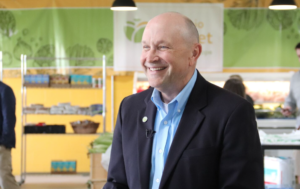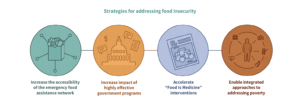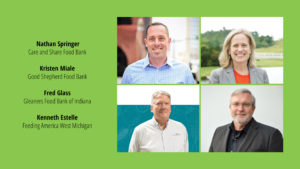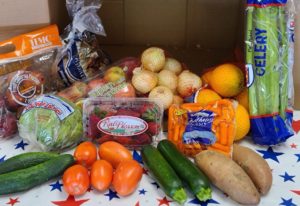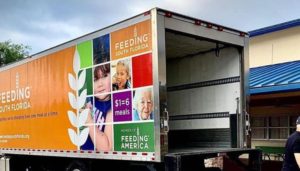Food banking may never be the same again.
After more than a year of being in crisis mode, food banks are settling into a new normal — meeting still-elevated need, but doing it more effectively than ever before thanks to 14 months of intense, pandemic-pressurized learning.
Among the Covid-inspired innovations likely to stick around long after the virus is gone are home deliveries, fortified pantry networks, and new distribution methods. A summer of social unrest, meanwhile, has underscored the need to also expand access to food in more equitable, culturally-sensitive ways.
It’s all adding up to food banks operating at much higher levels of performance, post-pandemic. “One thing we realized through all this is that we’re capable of much more than we thought we were,” said Michael P. Miller, President and CEO at River Bend Food Bank, the largest food bank in Iowa, with FY 2019 revenues of $40 million, according to Food Bank News’ listing of the 100 largest food banks.
Certainly, food banks are continuing to distribute more food than ever before. At the end of March, Feeding America released projections for 2021 showing that food insecurity remains elevated in nearly every county compared to pre-pandemic levels. While increased aid from the Biden Administration is starting to bring those rates down, food banks are still preparing for high, ongoing demand.

Second Harvest Food Bank of Central Florida is similar to many of its peers in the state in expecting that the amount of food it will distribute in FY 2020/2021 will increase by 45%, said Dave Krepcho, President and CEO at the $130 million-revenue (FY 2019) food bank, Florida’s second-largest. “It’s too early to tell about the Biden aid,” Krepcho said. “Demand may be lower than we predict, but we’d rather be prepared for the worst, versus something less,” he added, noting that food-insecurity rates took about a decade to recover from the impact of the Great Recession.
In addition to distributing more food, food banks are making strides in getting it to the homebound and elderly, thanks to a more intense focus on home delivery. Numerous food banks started up home delivery programs during the pandemic, sometimes even to their own surprise. “I never thought in my 29 years of food banking that I would see food banks doing home delivery,” Krepcho said.
As home delivery shifts from an emergency response to a standard offering, the challenge will be to keep it going at scale, said Brian Greene, President and CEO of Houston Food Bank, the largest in Texas with $209 million in FY 2019 revenue. At his food bank, he envisions using a combination of crowdsourcing and scheduled drivers.
Second Harvest of Central Florida, which is delivering about 1,200 meals a week, also hopes to incorporate more volunteers into its effort. High volume made it necessary to move away from volunteers early in the pandemic and rely on an existing courier-service relationship. “It does add expense, but we’re committed to it,” Krepcho said. “I really believe this is a program we will make stick around.”
Covid also put a spotlight on the vulnerability of pantry networks, which serve as the main distribution channels for food banks. Food banks responded by greatly increasing funds aimed at helping food pantries expand their capacity.

Greater Pittsburgh Community Food Bank, for example, sent $2 million worth of “stimulus checks” to its more than 600 agency partners, which account for 80% of its food distribution, said Lisa Scales, President and CEO of Pennsylvania’s third largest food bank, with FY 2019 revenue of $54 million. Agencies did not need to apply for the funding, which was based on the number of people typically served. It also made nearly $1 million available through impact grants, which agencies applied for to support improvements like refrigeration and shelving.
Similarly, Blue Ridge Area Food Bank expects to be able to fund the majority of $3 million in grants requested by pantries in its network of just over 200, said Michael McKee, CEO of the $51 million-revenue (FY 2019) food bank, Virginia’s second-largest. That’s up from about $300,000 in a typical year. “We’re making a much greater investment in agency capacity than ever before,” McKee said. “We’re really visioning the future of what the pantry needs to be in terms of leadership, staffing and service for the client.”
In addition to bolstering pantry capacity, many food banks expanded the size of their pantry networks during Covid. Greater Pittsburgh, for example, added 135 community-based organizations that were providing other social services, and had clients who also needed food. “None of them are full-blown pantries, but we’ll continue to support them,” Scales said.
In Minneapolis, the murder of George Floyd proved to be a game-changer for the way The Food Group reaches out to partners. With mutual-aid food distributions springing up across the city in the wake of the murder, The Food Group realized it needed to lower its barriers of entry into partnership, which typically requires a 501(c)(3) designation. “We learned this summer that there are other really good community food works happening that are much less formalized, and we can be a resource,” said Sophia Lenarz-Coy, Executive Director of The Food Group, which added 40 new partners in 2020.

Blue Ridge Area Food Bank is also working with non-traditional partners that are not members of the food bank, but participate in food distribution and outreach, mostly to immigrant and senior populations, McKee said. Engagement with these groups, which will expand going forward, requires the food bank to get much more involved in relationship-building at the community level, he said. “It really is on the ground. Very little is transactional. It’s relationship-building and that’s the big shift.”
Perhaps the most visible shift during Covid was a move to mass drive-through food distributions when Covid shuttered food pantries. Food banks got better at these over time, adding law enforcement expertise and space for extra drive-through lanes to better handle the crowds. East Texas Food Bank is one that plans to continue offering the convenience of large-scale distributions at a handful of sites monthly. “We’ll do trunk mode just because of the efficiency,” said Dennis Cullinane, CEO of East Texas, the state’s seventh-largest food bank, with 2019 revenue of $32 million.
Some food banks and pantries have worked to combine the convenience of drive-through pick-ups with the ability to order specific food through Instacart-like apps. The combination adds the dignity of choice to the efficiency of drive-throughs. As Courtney Wright, Senior Food Assistance Network Strategist at Oregon Food Bank, Oregon’s largest, put it in this Food Bank News article, “It’s one of those, ‘Why haven’t we been doing this all along?’ things.”
Other food banks found work-arounds to mass distributions from the get-go. San Diego Food Bank plans to continue supporting its network of “super pantries.” Open for extended hours and at least three days a week, the 35 super pantries were introduced as an alternative to mass distributions, allowing people to take advantage of drive-through service at their local pantry, sometimes even with reserved times for pick up. “There are no long lines,” said James Floros, President and CEO, adding, “Client dignity is of the utmost importance.”
Second Harvest of Central Florida also moved away from mass distributions in favor of more frequent, smaller-scale mobile distributions that bring tractor-trailers of food into various neighborhoods. “The crowd control is so much better versus people waiting in lines,” Krepcho said. “There’s a dignity aspect.” Second Harvest expects it will do about five such mobile distributions per week going forward, up from about two per week, pre-Covid.
Pressed into providing levels of service beyond what they ever could have imagined, food banks proved they could rise to the occasion, and more. “I’ve been in the hunger relief field for the past 13 to 14 years and what’s been so amazing about the past year is the pace of innovation,” said Lenarz-Coy. Agreed Scales, “The most exciting time to be a food bank is right now. It’s a time of transformation.” — Chris Costanzo
Like what you’re reading?
Support Food Bank NewsConnect with Us:

